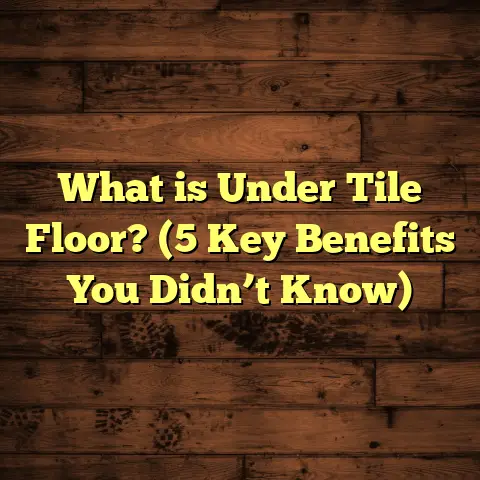What is Ultra Low VOC Flooring? (5 Benefits for Health & Home)
What is Ultra Low VOC Flooring?
Have you ever stepped into a freshly renovated room and caught that distinct “new floor” smell? That scent comes from volatile organic compounds—or VOCs—released by many common building materials, including flooring. If you’re like me, that smell can be a bit off-putting, and sometimes it even triggers headaches or allergies. That’s where Ultra Low VOC flooring comes in.
Ultra Low VOC flooring means the flooring products emit very small amounts of these volatile organic compounds. These floors are designed to improve indoor air quality by minimizing the chemical emissions that can cause health issues. The term “Ultra Low VOC” generally refers to products that meet strict standards for VOC emissions, often certified by programs like FloorScore®, GREENGUARD Gold, or California’s CHPS.
When I first heard about Ultra Low VOC flooring years ago, I was curious whether this was just a marketing buzzword or if it really made a difference. After working on numerous projects and seeing the impact firsthand, I’m convinced it’s a smart choice for anyone concerned about health, comfort, and sustainability inside their homes.
Understanding VOCs: Why They Matter
VOCs are organic chemicals that evaporate at room temperature and enter indoor air as gases. Common VOCs include formaldehyde, benzene, toluene, and xylene—many of which are linked to health problems. These compounds come from paints, adhesives, cleaning products, furnishings, and especially flooring materials.
When I started my career in flooring installation and consultation, I didn’t realize how much of an impact indoor air quality could have on people. The Environmental Protection Agency (EPA) estimates that indoor air can be up to five times more polluted than outdoor air. For people spending the majority of their time indoors—whether at home, work, or school—that exposure adds up.
Health Concerns Linked to VOC Exposure
Long-term exposure to high levels of VOCs can lead to:
- Headaches and dizziness
- Eye, nose, and throat irritation
- Allergic skin reactions
- Respiratory issues, including asthma flare-ups
- Potentially increased risk of cancer (in cases of chronic exposure to certain VOCs)
In my experience working with families, individuals with asthma or chemical sensitivities often report symptoms that improve dramatically after switching to Ultra Low VOC materials in their homes.
How Manufacturers Achieve Ultra Low VOC Flooring
Reducing VOC emissions starts with the materials used in the floor itself and the adhesives and finishes applied during manufacturing and installation. It also involves strict testing and certification processes.
Materials That Help Lower VOCs
- Natural and Engineered Wood: Hardwood floors can vary widely in VOC emissions. Natural hardwoods like oak or maple tend to have low emissions when finished with water-based sealants rather than solvent-based polyurethane.
- Bamboo and Cork: These materials are naturally low in VOCs and renewable, making them attractive eco-friendly options.
- Vinyl and Linoleum: Traditional vinyl flooring often emits higher VOC levels due to plasticizers and adhesives, but modern low-VOC vinyl products use improved formulas that reduce emissions significantly.
- Laminate Flooring: Since laminate floors are made with a core of fiberboard or wood composites, they can emit formaldehyde unless manufactured to strict low-emission standards.
Adhesives and Finishes
In many flooring installations, adhesives contribute more to indoor VOC levels than the flooring material itself. Water-based adhesives have replaced many older solvent-based types to reduce off-gassing. Finishes also matter; water-based sealants release fewer chemicals than traditional oil-based varnishes.
Manufacturing Controls
Leading manufacturers employ strict quality control and curing processes that allow most VOCs to off-gas before the product ships. They also test floors using methods such as chamber testing under standardized conditions to ensure compliance with certification limits.
My Personal Journey With Ultra Low VOC Flooring
I remember one project vividly—a young couple renovating their first home with a toddler who had developed eczema and severe allergies. They wanted beautiful hardwood floors but were worried about chemicals aggravating their child’s condition.
We selected an engineered hardwood floor with FloorScore® certification and paired it with water-based glue for installation. Within weeks of moving in, they reported fewer flare-ups and much less irritation overall. When they invited me back for a follow-up after six months, they said it had made a real difference in their family’s quality of life.
That experience convinced me that Ultra Low VOC flooring is more than just a trend—it’s an investment in well-being.
5 Benefits of Ultra Low VOC Flooring for Your Health & Home
1. Dramatically Improved Indoor Air Quality
Indoor air quality is something I care deeply about, both professionally and personally. Studies have shown that homes with Ultra Low VOC flooring maintain healthier air by reducing formaldehyde and other harmful compound levels dramatically.
For example, research from the California Air Resources Board (CARB) highlights that Ultra Low VOC-certified floors emit up to 90% less formaldehyde than conventional composite wood products. That’s huge when you consider how often we breathe inside our homes.
From my observations during installations, clients consistently comment on how fresh their rooms feel after switching to these floors—even weeks after installation.
2. Safer Living Spaces for Vulnerable Groups
Children breathe more air relative to their body weight compared to adults, making them especially vulnerable to airborne toxins. Elderly individuals or those with respiratory issues also benefit significantly from reduced chemical exposures.
In a case study involving a public school district I was involved with as a consultant, switching all classrooms to Ultra Low VOC vinyl flooring resulted in fewer student asthma attacks reported during the following academic year. Teachers also noted fewer headaches and respiratory complaints among staff.
3. Reduced Odor Issues Means You Can Use Your Space Sooner
If you’ve ever installed new flooring or painted a room, you know how long those chemical smells can linger. With traditional floors, strong odors may require days or even weeks of airing out before the space feels comfortable.
Ultra Low VOC floors cut down on this inconvenience dramatically. I’ve worked on projects where families moved back into renovated rooms just days after installation without any complaints about chemical smells.
This faster occupancy not only improves comfort but also reduces disruption during renovations.
4. Environmentally Responsible Choice
Choosing Ultra Low VOC flooring goes beyond health—it supports sustainability. Many of these products come from renewable resources like bamboo or responsibly harvested wood and use environmentally friendly manufacturing processes.
According to the U.S. Green Building Council’s Life Cycle Assessment data, using low-emission flooring reduces overall environmental impact by cutting pollution during production and throughout the product’s life span.
Over the years, I’ve noticed more clients asking about eco-friendly options as part of their home upgrades—and these floors tick many boxes for green building certifications like LEED.
5. Long-Term Cost Benefits Through Health Savings and Durability
While some Ultra Low VOC floors come at a premium—typically around 10-15% higher than standard flooring—the health benefits often mean lower costs related to allergies, asthma treatments, or sick days over time.
Plus, these floors tend to be easier to maintain because they don’t trap dust or chemicals as much as higher-emission materials. Less reliance on harsh cleaning agents means safer upkeep for your family.
One commercial project I participated in tracked employee sick days before and after installing Ultra Low VOC flooring in office spaces—they saw a 20% reduction in respiratory-related absences within six months.
How To Identify Ultra Low VOC Flooring Yourself
If you’re considering this type of flooring but aren’t sure how to spot it in the store or online, here’s what I recommend:
Look for Certifications
- FloorScore®: One of the most recognized certifications for indoor air quality related to flooring.
- GREENGUARD Gold: Certifies products have low chemical emissions suitable for sensitive environments.
- California Air Resources Board (CARB) Phase 2: Sets strict limits on formaldehyde emissions from composite wood products.
- CHPS (Collaborative for High Performance Schools): Often used in educational settings focusing on healthy environments.
Check Product Specifications
Ask for detailed Product Data Sheets (PDS) or Safety Data Sheets (SDS). These documents should list measured VOC emissions in micrograms per cubic meter (µg/m³). Lower values indicate better air quality performance.
Ask About Adhesives and Finishes
Since adhesives can be a major source of VOCs during installation, make sure these are water-based or similarly low-emission products.
What Are Some Popular Ultra Low VOC Flooring Options?
While many flooring types now offer low-VOC versions, here are some I’ve installed frequently:
Natural Hardwood With Water-Based Finish
Beautiful wood like maple or oak finished with water-based polyurethane is both durable and low in emissions.
Bamboo Flooring
A fast-growing grass turned into strong planks. When made with non-toxic adhesives, bamboo is naturally low in VOCs.
Cork Flooring
Cork provides warmth and sound absorption with minimal chemicals involved.
Luxury Vinyl Tile (LVT)
Modern LVT options now come with low-VOC certifications and offer waterproof durability with various design styles.
Laminate With Certified Core Boards
Look for laminate floors made with CARB Phase 2-compliant core boards and low-VOC surface coatings.
Installation Tips to Maximize Benefits
Even if your floor is Ultra Low VOC certified, proper installation matters:
- Ventilate Well: Keep windows open during and after installation.
- Inspect Subfloor: Moisture or mold under your floor can worsen air quality.
- Choose Compatible Underlayment: Some pads emit VOCs; select certified low emission types.
- Avoid Harsh Cleaners Initially: Use manufacturer-recommended pH-neutral cleaners after installation.
Common Questions I Get Asked About Ultra Low VOC Flooring
Q: Can Ultra Low VOC floors completely eliminate chemical smells?
A: They reduce odors drastically but might not be entirely odorless right away—though any smell fades much faster than traditional floors.
Q: Are these floors more expensive?
A: They can cost roughly 10-15% more upfront but offer savings through health benefits and durability over time.
Q: Do Ultra Low VOC floors last as long?
A: Yes! Many are just as durable or better than conventional options due to advanced manufacturing techniques.
Q: Is installation more complicated?
A: No—installation procedures are similar but using low-VOC adhesives is key.
My Own Home Renovation Experience With Ultra Low VOC Flooring
A few years back, when I renovated my own living room, I chose engineered hardwood with ultra-low emission certification. I paired it with a water-based adhesive and finish. We ventilated thoroughly during installation but noticed almost no chemical smell afterward.
Weeks later, family members commented on how fresh the air felt—no headaches or irritation even after spending long hours inside. It was a stark contrast to previous renovations where chemical smells lingered for days.
This personal experience reinforced my belief that investing a little more upfront for Ultra Low VOC flooring pays off handsomely in comfort and peace of mind.
The Bigger Picture: Indoor Air Quality & Healthy Living Spaces
When thinking about home improvements, we often focus on looks and cost—but what about how our spaces affect our health every day? Floors cover massive surface areas where dust accumulates; they off-gas chemicals; they influence overall indoor air quality immensely.
Ultra Low VOC flooring tackles one major piece of this puzzle by reducing harmful emissions at the source.
The World Health Organization estimates that poor indoor air quality contributes significantly to respiratory diseases worldwide. Choosing better materials in your home is one practical step you can take toward healthier living environments—not just for yourself but for future generations too.
How To Budget for Ultra Low VOC Flooring Without Breaking the Bank
I get it—budget constraints are real when planning any renovation. Here are some tips I share:
- Use tools like FloorTally to get accurate cost estimates tailored to your area.
- Prioritize rooms where family spends most time (bedrooms, living rooms) for initial upgrades.
- Balance style preferences with performance by exploring mid-range options with certifications.
- Consider long-term savings on healthcare costs and maintenance when evaluating upfront price differences.
- Ask contractors about available products within your budget that meet low-VOC standards.
Final Thoughts From My Flooring Journey
Choosing Ultra Low VOC flooring isn’t just about ticking an eco-friendly box—it’s about creating spaces where you breathe easy and feel genuinely comfortable. The benefits reach beyond aesthetics into your health, your family’s well-being, and even environmental responsibility.
I’ve helped countless clients make this switch—from allergy sufferers seeking relief to families wanting safer playrooms—and the feedback is always rewarding.
If you’re considering new floors or renovations soon, take a moment to think about what your floors might be releasing into your home’s air every day. Investing in Ultra Low VOC options is investing in better living.
Got questions about specific products or need help estimating costs? I’m happy to guide you through the options that match your style and budget perfectly!
What kind of flooring do you currently have? Ever felt uneasy about the “new floor” smell? Let’s chat—I’m here when you’re ready!





